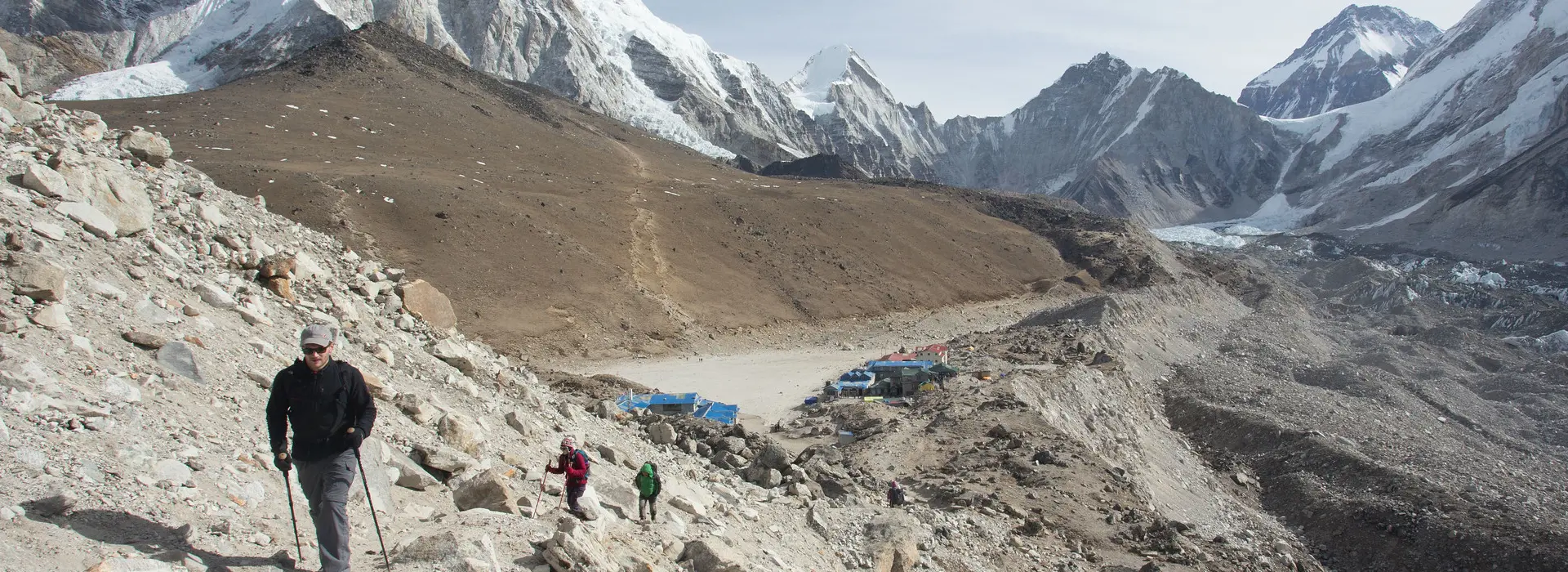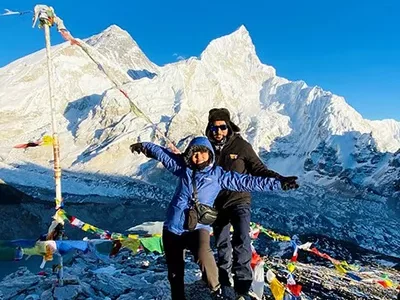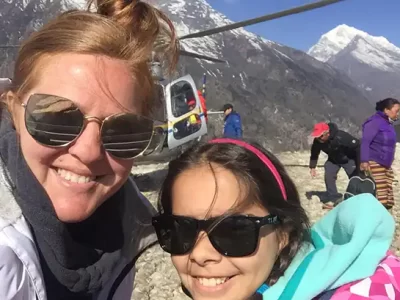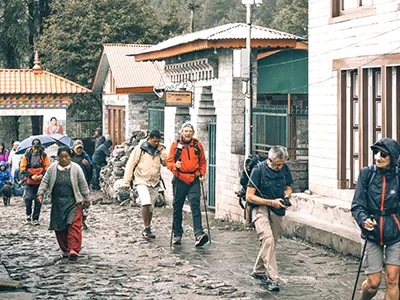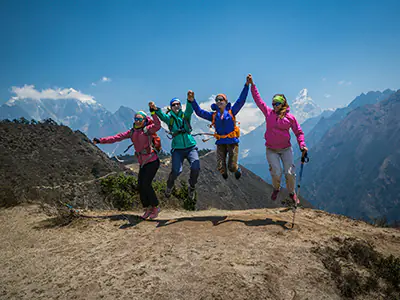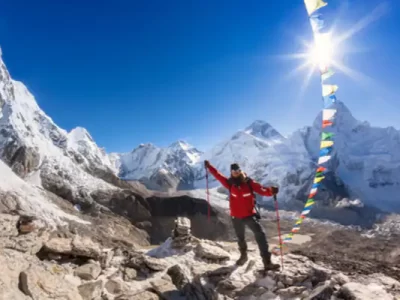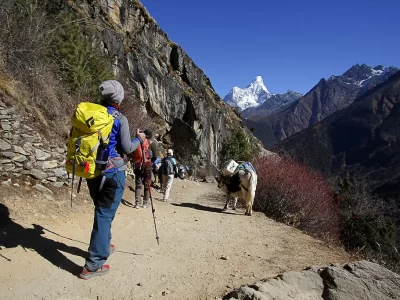Hello from Kathmandu, Nepal! Welcome to Peregrine Treks and Tour, the home of unforgettable adventures in Nepal. We started operating in 2002 and have been offering great holiday packages, which include city breaks, remote trekking trips, and yoga retreats. In a bid to improve our services, we keep on working hard, and this has made us receive good ratings globally, hence becoming one of the leading travel agencies in Kathmandu.
Common Everest Base Camp Trek FAQs
- What is the best time of year to trek to Everest Base Camp?
- How fit do I need to be to complete the trek?
- What permits are necessary for undertaking the Everest Base Camp Trek, and where can one obtain them?
- How long typically does completing the Everest Base Camp Trek take, and what variables can affect this timeframe?
- What distance do trekkers typically traverse each day on the Everest Base Camp Trek, and what are the usual hours spent walking?
- What is the accommodation like?
- What is the food like?
- Where can I have a hot shower?
- How often can I charge my phone and camera batteries?
- Where is Wi-Fi available?
- Do you provide a porter, or should I carry my luggage?
- What risks does altitude sickness pose on the Everest Base Camp Trek, and how can trekkers prevent it?
- What highlights define the Everest Base Camp Trek?
- How do trekkers reach the Everest Base Camp Trek’s starting point?
- What does the toilet and hygiene situation look like on the trek?
- Should I get travel insurance for the trek, and what should it include?
- What is the trek’s highest altitude point?
- What weather conditions should trekkers expect on the Everest Base Camp Trek?
- What cultural and environmental norms must trekkers follow on the Everest Base Camp Trek?
- Where can trekkers store excess luggage before starting the Everest Base Camp Trek?
- What emergency procedures are in place on the Everest Base Camp Trek?
- Why is tipping necessary? What is the standard rate of tipping?
- Where can I exchange my money?
Everest Base Camp Trek
Everest Base Camp Trek with Helicopter Return
Luxury Everest Base Camp Trek
Answers to Everest Base Camp Trek FAQs given by our guides:
My name is Nima, and I am a senior trekking and climbing guide with Peregrine Treks. Having reached the summit of Mount Everest, Mount Manaslu, and Mount Cho-Oyu twice, I bring years of experience in the Everest Region. Below, I will address a few questions based on this expertise:
What is the best time of year to trek to Everest Base Camp?
Trekking to Everest Base Camp typically takes place from mid-September to May, offering a variety of climates and trekking experiences. October stands as the peak trekking season, celebrated for its optimal weather conditions. During this month, trekkers enjoy clear skies, moderate temperatures, and the sun’s warmth, creating ideal hiking conditions. Despite the high season’s allure, some trekkers opt for the quieter winter months (December to February), enjoying the peaceful paths and smaller crowds.
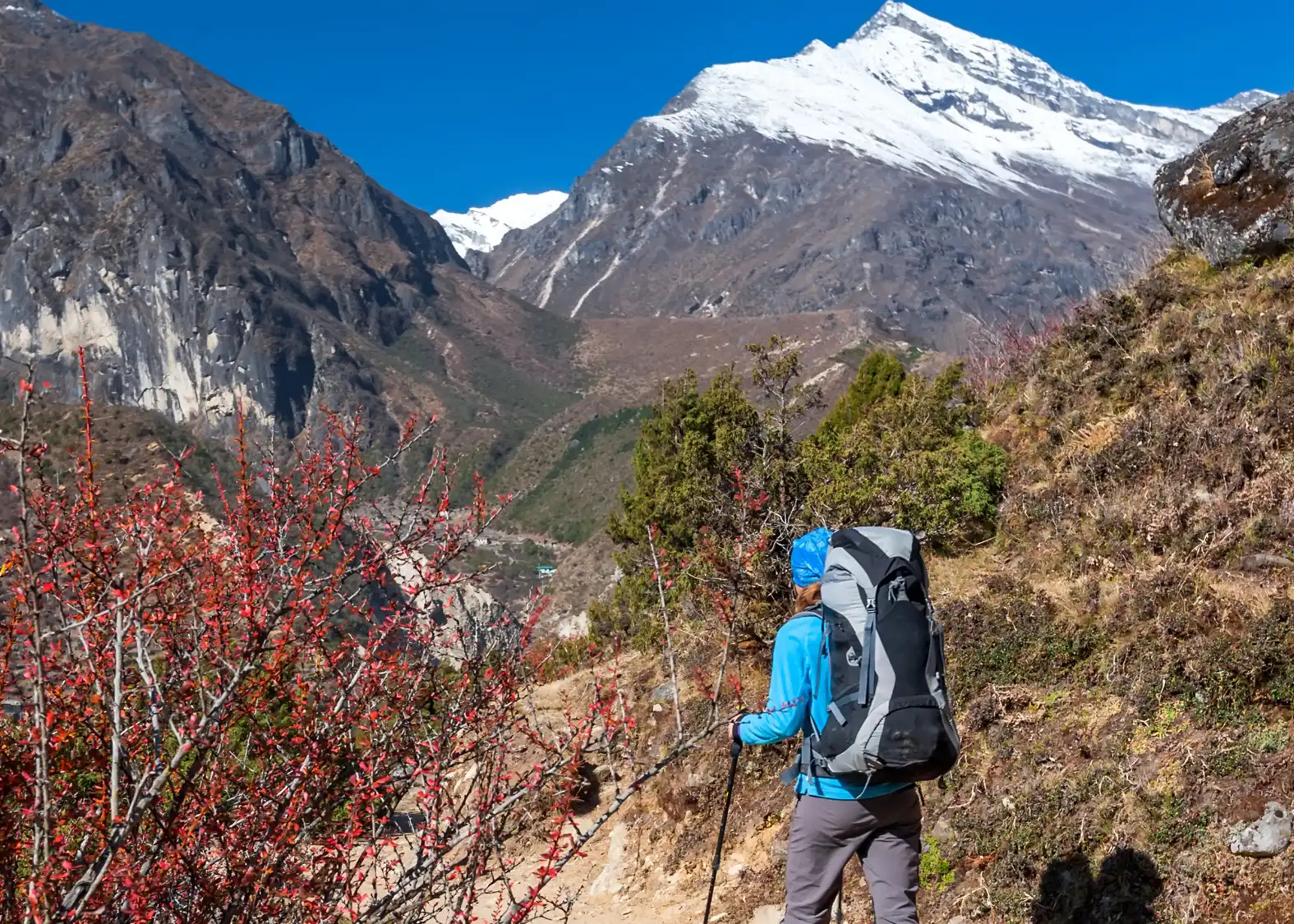
In winter, temperatures around Everest Base Camp often drop significantly, sometimes nearing freezing. It requires trekkers to equip themselves with adequate warm clothing. Essential items include thermal layers, down jackets, and sleeping bags designed to withstand the harsh cold, ensuring both safety and comfort during the trek.
More climbers and trekkers come as temperatures rise during March and April. Most of them want to climb Mount Everest, and this makes the trails and places to stay very busy. The mountains still look good, though they still need to be clearer during fall, but people still go there.
The spring months see particularly high activity at Everest Base Camp, with visitor numbers often matching or surpassing those in the peak autumn season. Estimates suggest that over 30,000 trekkers visit during this period, drawn by the favorable conditions for summiting Everest.
The varied weather conditions from autumn through spring present several risks, including sudden weather changes that can trigger avalanches or bring severe cold spells. These conditions demand preparedness and caution.
Helicopter services play a vital role throughout these months, offering essential emergency rescues and evacuations. They remain especially active during peak seasons when the risks of altitude sickness, injuries, or adverse weather effects increase. Their availability provides rapid response capabilities, which are critical for addressing emergencies efficiently and effectively.
Understanding these seasonal dynamics is crucial for anyone planning a trek to Everest Base Camp. It aids in selecting the best time for the trek, preparing adequately for weather conditions, and ensuring safety measures, including proper gear and potential helicopter evacuation, are in place.
How fit do I need to be to complete the trek?
Achieving a moderate fitness level is crucial for completing the trek successfully. Having experience in hiking or trekking can greatly benefit you. It would help if you carried a light daypack across terrain featuring steep ascents and high-altitude paths, testing your physical endurance and strength.
To prepare yourself for the trek, you must undertake consistent cardiovascular training, such as running, swimming, or biking, and integrate strength-building exercises. This regimen will boost your stamina and muscle power, easing the lengthy daily treks and helping you adjust to the fluctuating elevations and challenging landscapes you’ll face.
What permits are necessary for undertaking the Everest Base Camp Trek, and where can one obtain them?
To embark on the Everest Base Camp Trek, securing a Trekkers’ Information Management System (TIMS) card and a Sagarmatha National Park permit is mandatory. The TIMS card plays a crucial role in maintaining the trekkers’ safety and enables authorities to track individuals in emergencies. Trekking enthusiasts can obtain this card either in Kathmandu or Pokhara at the Nepal Tourism Board’s offices or via certified trekking agencies.
Additionally, entering the Everest region necessitates a Sagarmatha National Park permit, obtainable through the Nepal Tourism Board in Kathmandu or at the Monjo checkpoint, which serves as an entrance to the park.
Peregrine Treks and Tour typically manages the procurement of these permits. They efficiently handle all the required formalities, thus ensuring that trekkers can concentrate on preparing for their journey.
How long typically does completing the Everest Base Camp Trek take, and what variables can affect this timeframe?
Typically, completing the Everest Base Camp Trek takes between 12 and 14 days, with these days including the necessary time for acclimatization to prevent altitude sickness. The length of the trek, however, can differ depending on the selected route.
Trekkers have the option of longer itineraries that feature extra attractions or acclimatization stops, or they may choose more straightforward, shorter routes. The duration of the trek can also be influenced by the trekker’s physical condition, weather conditions, and individual walking pace, leading to a customizable trekking experience that caters to the needs and preferences of each trekker.
Everest Base Camp Trek for Beginners
Jiri to Everest Base Camp Trek
Everest Base Camp Short Trek
What distance do trekkers typically traverse each day on the Everest Base Camp Trek, and what are the usual hours spent walking?
On the Everest Base Camp Trek, trekkers usually traverse between 10 and 15 kilometers each day, equating to roughly 5 to 7 hours of walking. This walking time can vary with the trail’s elevation and the ruggedness of the terrain, with more demanding and steeper segments necessitating additional time.
We strategically set the walking pace to support acclimatization to higher altitudes, ensuring trekkers can comfortably manage the journey while taking in the breathtaking vistas and cultural experiences along the way.
What is the accommodation like?
Our trek to Everest Base Camp features nightly stays in tea houses or mountain lodges, offering straightforward yet comfortable lodging options. These establishments provide both private and shared rooms, with the latter being more common.
While some rooms boast en suite facilities, others have shared bathroom amenities. We prioritize ensuring our trekkers have a proper bed to rest in after a day’s hike. So, we want you to know that we strive to secure the best accommodations available for our clients.
What is the food like?
On your trekking journey, tea houses along the route offer a consistent menu. Nonetheless, we take special care in choosing tea houses known for their hygienic, tasty, and wholesome meals. The typical menu includes local favorites like Nepali Daal Bhat Tarkari (a combo of lentil soup, rice, and vegetables), momo (dumplings), and Chowmein (fried noodles).
Snack options often feature Wai-Wai or Rara, which are popular packaged crispy noodles. We advise against consuming meat at higher elevations due to the lack of direct transportation; meat often has to be carried up by porters and can be days old, sometimes relying on freezing methods, increasing the risk of food poisoning. To maintain health, avoiding meat is recommended.
Where can I have a hot shower?
Hot showers are accessible at specific points along the trek, including Ghat, Namche, Deboche, Dingboche, Lobuche, Dole, and Machhermo. Tea house proprietors may impose a fee for hot shower facilities, typically ranging from 300 to 650 Nepali rupees, subject to availability.
How often can I charge my phone and camera batteries?
Throughout your journey to EBC, charging opportunities for your electronics are available at the tea houses or mountain lodges, which typically provide 24-hour electricity. You’ll have the chance to charge your devices during lunch breaks and overnight stays. Since most places have two power outlets, we advise bringing a universal converter that matches your gadgets. Charging fees vary based on location and electrical access, usually between 200 to 300 Nepali Rupees (NRS).
Electricity is accessible in these areas:
- Lukla
- Ghat
- Monjo
- Namche
- Deboche
- Dingboche
- Lobuche
- Gorak Shep
Please let me know where Wi-Fi is available.
We set up Wi-Fi access points in locations like Lukla, Namche, Dingboche, Lobuche, and Gorak Shep. Some places may levy charges for Wi-Fi usage.
Do you provide a porter, or should I carry my luggage?
Peregrine Treks can arrange a porter for you upon booking. Typically, we assign one porter to manage the luggage of two trekkers, with a carrying capacity limit of 30kg. It means that each trekker should limit their luggage to at most 15kg. If needed, requesting a private porter incurs an additional fee.
What risks does altitude sickness pose on the Everest Base Camp Trek, and how can trekkers prevent it?
The Everest Base Camp Trek carries the risk of altitude sickness due to high-elevation climbs, where the air is thinner and oxygen levels are lower. To counter this, trekkers must acclimatize properly, gradually increasing their altitude to let their bodies adjust. Drinking plenty of water aids in this acclimatization process and helps avoid dehydration, which can worsen the symptoms of altitude sickness.
Eating nutrient-rich food is vital for maintaining energy levels and supporting acclimatization. Progressing slowly up the mountain gives the body the necessary time to adapt. Under a doctor’s guidance, trekkers might also consider taking medications like acetazolamide to aid in preventing or treating altitude sickness.
What highlights define the Everest Base Camp Trek?
Renowned for its stunning natural beauty and cultural richness, the Everest Base Camp Trek offers unmatched views of Mount Everest and the surrounding Himalayan giants. Trekkers delve into Sherpa culture, experiencing the warm hospitality and traditions of this community.
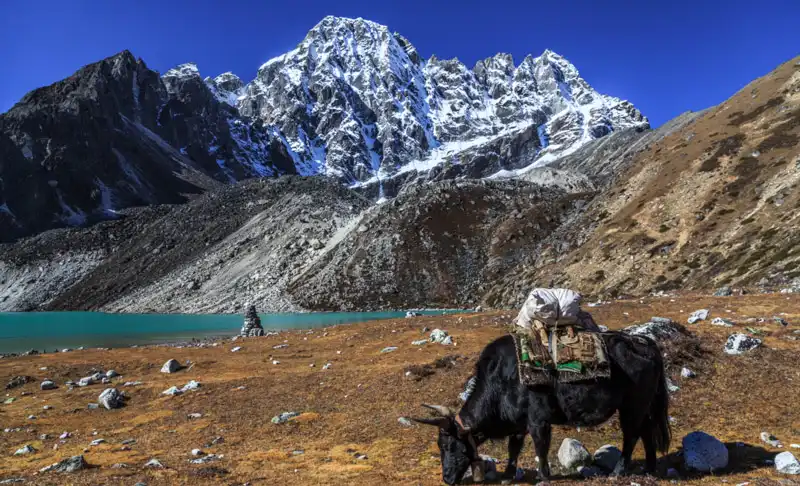
The journey features visits to picturesque monasteries like Tengboche, providing a glimpse into the region’s Buddhist culture. The trek traverses the Sagarmatha National Park, a UNESCO World Heritage Site, showcasing a diverse array of high-altitude flora and fauna, highlighting the unique ecological and cultural aspects of the region.
How do trekkers reach the Everest Base Camp Trek’s starting point?
Lukla serves as the primary gateway to the Everest Base Camp Trek, with most trekkers flying in from Kathmandu for a short, scenic journey that offers stunning Himalayan vistas. Alternatively, for an extended trekking experience, starting from Salleri or Jiri adds extra days to the itinerary, allowing for a gentler ascent and better acclimatization. This route also presents the opportunity to explore the varied landscapes and cultures of the region before reaching Lukla.
What does the toilet and hygiene situation look like on the trek?
Toilet facilities on the Everest Base Camp Trek range from basic squat toilets to western-style toilets, particularly in more popular tea houses or lodges. Hot showers are accessible at select locations for a fee, which can vary depending on the altitude and the specific tea house.
Carrying personal hygiene supplies, including hand sanitizer, wet wipes, and toilet paper, is essential for trekkers to maintain cleanliness and prevent illness, as the provision of these items at tea houses is not always guaranteed and may come with a cost.
Should I get travel insurance for the trek, and what should it include?
Acquiring comprehensive travel insurance is essential for trekkers heading to Everest Base Camp, covering high-altitude activities to manage any medical issues affordably, especially those associated with altitude sickness. Insurance should also cover emergency evacuation to address severe health concerns requiring quick descent and medical treatment.
Furthermore, considering insurance that includes trip cancellation or interruption is prudent, safeguarding against unexpected changes in travel plans. Trekkers should ensure their policy remains effective up to at least 5,500 meters to guarantee coverage throughout the trek.
What is the trek’s highest altitude point?
Reaching Everest Base Camp marks the trek’s apex at an altitude of 5,364 meters (17,598 feet). The ascent to this height is challenging due to decreased oxygen levels and thinner air, necessitating scheduled acclimatization days in the itinerary.
These acclimatization periods are crucial for trekkers to adjust gradually to high altitudes, reducing altitude sickness risks. The route to this elevation exposes trekkers to varied landscapes and affords stunning Himalayan panoramas, rewarding their efforts with spectacular scenic vistas.
What weather conditions should trekkers expect on the Everest Base Camp Trek?
Trekkers will encounter highly variable and rapidly changing weather on the Everest Base Camp Trek. Higher altitudes bring cold conditions, significant temperature drops, and potential snowfall, while the trek’s lower regions can be warmer. The weather is milder during the pre-monsoon spring season from March to May and clearer and more stable during the post-monsoon autumn season from September to November. Trekkers need to prepare for a wide range of temperatures and weather conditions throughout the trek.
What cultural and environmental norms must trekkers follow on the Everest Base Camp Trek?
Trekkers must respect local customs and environmental norms during the Everest Base Camp Trek. Dressing modestly, especially in monasteries and villages, shows respect for local culture. Trekkers should always ask for permission before taking photos of locals to respect their privacy and traditions. Environmentally, adhering to Leave No Trace principles is crucial, including carrying out all trash, minimizing plastic use, and avoiding disturbance to wildlife or plant life to help preserve the region’s natural and cultural integrity.
Where can trekkers store excess luggage before starting the Everest Base Camp Trek?
In Kathmandu, trekkers have the option to store their excess luggage before starting the Everest Base Camp Trek. Most hotels in the city offer secure storage services, enabling trekkers to travel lighter and keep non-essential items safely until they return. This service is usually provided for free or at a nominal charge, depending on the hotel’s policy.
What emergency procedures are in place on the Everest Base Camp Trek?
During the Everest Base Camp Trek, if trekkers experience serious illness or injury, they can access emergency evacuation procedures, including helicopter services to Kathmandu. Trekkers must have travel insurance that includes coverage for high-altitude evacuation and medical treatment. Collaborating with a reputable guide or agency knowledgeable in emergency protocols ensures trekkers’ safety, as these professionals can manage and respond efficiently to emergencies on the trek.
Why is tipping necessary? What is the standard rate of tipping?
Tipping serves as an expression of gratitude towards your guide and porter for ensuring your safety and guiding you successfully to your destination. Typically, the tipping rate in trekking amounts to about 20% of the total cost of the trek. Nevertheless, the amount and recipient of your tip are at your discretion. We advocate for recognizing the effort our staff puts in and encourage tipping them generously.
Where can I exchange my money?
Upon your arrival in Kathmandu, you will have a day for personal activities, such as exchanging money or shopping. Money exchange facilities are easily accessible in Thamel and other major tourist areas in Kathmandu. It’s less likely to find money exchange services in the Everest region, which is why exchanging your money in Kathmandu is recommended.
Why Peregrine Treks?
My long tenure with Peregrine Treks has allowed me to serve a myriad of clients, all of whom were content with our services. Peregrine Treks stands out for its reliable service, knowledgeable trekking guides, adaptable itineraries, and efficient expense optimization. Our team, from the Chairman to the guides and porters, collaborates seamlessly to ensure each travel package runs smoothly. Their friendly and attentive approach consistently earns high praise.
So, when deciding on the best, go for the top player in the field. We invite you to Nepal, especially during the Visit Nepal Year 2020, to experience the country’s stunning geographical and cultural diversity. Join us and be part of making the Visit Nepal Year 2020 a grand success.
About Us
Peregrine Treks and Tour consists of a group of dedicated and passionate travel enthusiasts. Mr. Pradip Karki, the Chairman, leads our team in Kathmandu, tirelessly assisting clients with their bookings and queries. Ms. Jamuna Bhandari, our director, alongside a team of eight indoor members, ensures the agency runs efficiently. Our outdoor team includes seven trekking guides, featuring a professional yoga guide and three specialized mountain climbing guides, in addition to two tour guides.
Specializing in trekking across Nepal, Peregrine Treks boasts a wealth of experience, particularly with the Everest Base Camp Trek, our most acclaimed destination. Our extensively experienced guides lead treks to Everest Base Camp, and we have crafted our services to address FAQs from trekkers worldwide.
